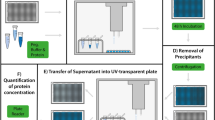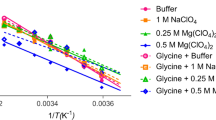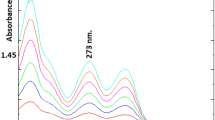Abstract
IN 1937 Kuhn and Desnuelle1 prepared a highly purified specimen of Warburg's yellow enzyme, and as evidence of purity they pointed out that when ammonium sulphate was added to the solution the yellow colour and the protein began to come out of solution at the same salt concentration, and that the decrease in yellow colour and the decrease in protein content were parallel. They did not develop the test further, nor did they successfully apply it to the analysis of impure solutions.
This is a preview of subscription content, access via your institution
Access options
Subscribe to this journal
Receive 51 print issues and online access
$199.00 per year
only $3.90 per issue
Buy this article
- Purchase on Springer Link
- Instant access to full article PDF
Prices may be subject to local taxes which are calculated during checkout
Similar content being viewed by others
References
Ber. Dtch. Chem. Ges., 70, 1907 (1937).
J. Biol. Chem., 109, 755 (1935).
C.R. Soc. Biol, 121, 1019 (1936).
C.R. Soc. Biol, 122, 231 (1936).
J. Gen. Physiol., 20, 475 (1937).
Physiol. Rev., 5, 349 (1925).
Author information
Authors and Affiliations
Rights and permissions
About this article
Cite this article
FALCONER, J., TAYLOR, D. A New Type of Phase Rule Solubility Test for Enzyme Purity. Nature 155, 303–304 (1945). https://doi.org/10.1038/155303a0
Issue Date:
DOI: https://doi.org/10.1038/155303a0
Comments
By submitting a comment you agree to abide by our Terms and Community Guidelines. If you find something abusive or that does not comply with our terms or guidelines please flag it as inappropriate.



